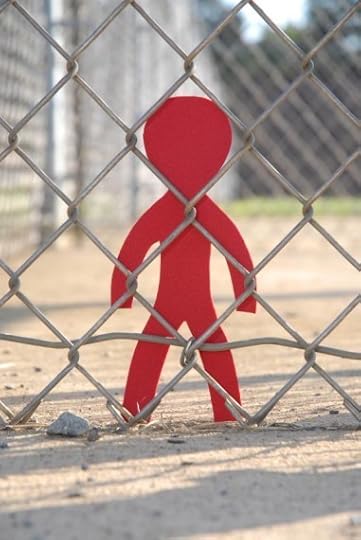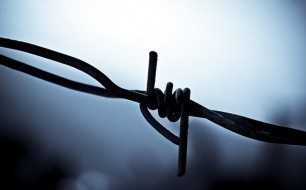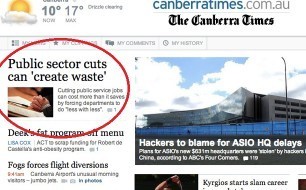Centre for Policy Development's Blog, page 69
June 11, 2013
ABC Australian Network News | 11 June 2013
 Australian government calls off search for asylum seekers
Australian government calls off search for asylum seekersA brief interview with Arja Keski-Nummi, one of the authors of the Refugee Facts online media resource concluded Thom Cookes’s report on responses to the recent influx of asylum seeker boats heading for Australia from Indonesia and Sri Lanka.
As in her interviews in yesterday’s Sydney Morning Herald and on Melbourne radio station 3AW, Arja called for constructive debate and regional cooperation in formulating a long-term asylum seeker policy.
Arja is a CPD fellow and former senior executive with the Department of Immigration and Citizenship. She co-wrote A New Approach in 2011 and the Refugee Facts media resource, which was published online this year.
The Sydney Morning Herald | 11 June 2013
 Arja Keski-Nummi interviewed: Abbot plan to stop boats ‘won’t work’…
Arja Keski-Nummi interviewed: Abbot plan to stop boats ‘won’t work’…Arja is a CPD fellow and former First Assistant Secretary of the Refugee, Humanitarian and International Division of the Dept of Immigration and Citizenship. She worked with John Menadue and Kate Gauthier to produce A New Approach in 2011 and more recently to release the Refugee Facts online media resource, aiming to counter the misinformation which has been rife in the media on this subject.
Arja Keski-Nummi, a fellow at the Centre for Policy Development and former head of the refugee division in the Immigration Department, said only enhanced regional co-operation would reduce the numbers of asylum seekers trying to reach Australia by boat.
”The most important thing is to try and assist people so they don’t have to get on to boats,” she said.
Ms Keski-Nummi said that despite the Coalition’s promise that it would ”stop the boats” if elected, its plans to turn boats around, reintroduce TPVs and maintain offshore processing would not work.
”If they’re in government, they’re going to own the issue and they’ve made a lot of promises, that I frankly can’t see that they can fulfil. And the main one is stopping the boats,” she said.
Read the full article on SMH.com.au
Access the Refugee Facts online media resource and please ‘like’ the Refugee Facts Facebook page
Radio 3AW, Drive | 11 June 2013
 Which way forward for asylum-seeker policy?
Which way forward for asylum-seeker policy?Tom Elliott interviews CPD fellow Arja Keski-Nummi.
The hedge fund MD and radio presenter questioned Arja’s expert opinion that ’turning back the boats’ will not stem the flow of asylum seekers and that it is important to treat regional neighbours such as Indonesia with respect and cooperation to achieve long term improvement.
As in the same day’s Sydney Morning Herald interview, Arja strongly advocated incorporating robust and respectful regional cooperation.
Arja is a seasoned expert in the field of refugee and immigration policy, having served with DIAC and in consultation with UN and other agencies for many years. As a CPD fellow, Arja worked with John Menadue AO and Kate Gauthier on A new approach: breaking the stalemate on refugees and asylum seekers in 2011, and in the Refugee Facts online media resource which went live this year. Refugee Facts seeks to provide
Play back the 3AW Drive program (find Arja Keski-Nummi’s interview 2 hours into this podcast)
Arja Keski-Nummi interviewed by Judith Ireland in The Sydney Morning Herald, 11 June 2013
Access the Refugee Facts online media resource and please ‘like’ the Refugee Facts Facebook page
June 7, 2013
AGL Blog | 4 June
CPD research director for the Sustainable economy program, Laura Eadie has had a gratifying response to her article in The Conversation last week. Aside from over 50 direct comments, the article was also republished in The Brisbane Times, and perhaps most remarkably was recommended on the blog of major energy company AGL – valuable exposure for progressive ideas, to business interests and consumers alike.
In the article to which this refers, Laura argued for policies to support consumers who choose to capture solar energy, in the face of recent industry calls to penalise them to ensure they share network maintenance costs. According to expert industry commentator Tim Nelson,
[The] piece by Laura Eadie is well worth a read. It is a very sensible contribution to a very difficult topic. Much has been said in the media recently about restructuring tariffs with regard to solar PV. However, little has been said about the need to consider tariffs more broadly and the importance of price signals for encouraging efficient energy use.
Read and (please!) comment on the AGL blogpost
Read Laura Eadie’s article, on The Conversation
Read Laura Eadie’s article in The Brisbane Times
June 6, 2013
The Conversation | 3 June 2013
Access Laura Eadie’s article in The Conversation
CPD research director Laura Eadie makes a clear and robust case for supporting rooftop solar – for the long term benefit of all electricity consumers.
In the wake of industry pressure to charge solar customers more for network maintenance, this excellent article spurred a strong response, with more than 50 comments, as well as editorial coverage in The Brisbane Times.
GetUp! | ‘Every child, every school’, features CPD authors
Access online campaign, read Chris’s policy paper and sign the GetUp petition
This position paper was commissioned by GetUp, and written by education expert and Centre for Policy Development fellow, Chris Bonnor.
It borrows from his book What makes a good school, which he co-wrote with Jane Caro, as well as their chapter in Pushing our luck, a forthcoming book from the Centre for Policy Development.
In addition to the video below, CPD fellow Chris Bonnor contributed a policy paper based on his and Jane Caro’s chapter from forthcoming election 2013 book, Pushing our luck.
June 2, 2013
APN group: Sunshine Coast Daily, Coffs Coast Advocate, etc… | 28 May
Christopher Stone’s Doing less with less was published in over 30 daily and community papers
False economies second instalment Doing less with less suggests sometimes cutting public service budgets can cost more than it saves. Shifting responsibility to the private sector is not a cost-effective strategy when the public sector is better placed to provide essential services. Adam Carroll of APN outlines the findings of Christopher Stones’ report in his article ‘Public service cuts can end up costing governments more’.
“Paring back the public service in the name of saving money can end up having the opposite effect”
Check out the article at the Sunshine Coast Daily
The article was also published in: Sunshine Coast Daily, Gympie Times, Gladstone Observer, Bundaberg News-Mail, Coffs Coast Advocate, Clarence Valley Daily Examiner, Fraser Coast Chronicle, Ipswich Queensland Times, Mackay Daily Mercury, My Daily News, Northern Star, Rockhampton Morning Bulletin, Toowoomba Chronicle, Warwick Daily News, Ballina Shire Advocate, Byron Shire News, Caboolture News, Central Telegraph, Coolum & North Shore News, CQ News, Northern Rivers Echo, Gatton Star, Ipswich Advertiser, Noosa News, Range News, South Burnett Times, Stanthorpe Border Post, Surat Basin Online, The Reporter, The Satellite, and Whitsunday Times
The Canberra Times | 28 May
 Front page of The Canberra Times! Public cuts can ‘create waste’
Front page of The Canberra Times! Public cuts can ‘create waste’Doing less with less receives strong coverage
CPD’s new report by research director Christopher Stone, Doing less with less, second instalment to False economies, has been covered by Ross Peake, senior reporter of The Canberra Times. His article explains how it can cost more than it saves when public sector jobs are cut and summarises the main points of the report:
“Author Christopher Stone says shifting responsibility to the private sector is not necessarily a cost-effective strategy when the public sector is better placed to provide essential services”
Download
‘False economies’ part 2: ‘Doing less with less’
Read Ross Peake’s article at The Canberra Times
[image error] Help CPD counter evidence-free attempts to outsource, downsize and privatise our public services – Become an Ideas Sustainer
May 27, 2013
ABC Media Watch | 27 May 2013
 Media Watch: Disclosing the funding of think tanks
Media Watch: Disclosing the funding of think tanksABC1′s program investigating media and public affairs turned its attention once again to the Australia’s top eight think tanks (which gratifyingly includes CPD).
Of these eight, CPD is one of only three which have a policy of disclosing funders (other than small, individual funders who wish to remain anonymous).
Media Watch researchers put a list of searching questions to each think tank, and published the responses on its website. Miriam Lyons’s original response on behalf of CPD, alongside responses from the McKell Institute, Grattan Institute, Centre for Independent Studies, Sydney Institute, The Australia Institute and Per Capita, while the Institute of Public Affairs’ brief reply is summarised in the transcript.
Read CPD’s funding disclosure replies: abc.net.au/mediawatch/transcripts/1317_cpd.pdf
Read the full transcript and play back the segment: abc.net.au/mediawatch/transcripts/s3768536.htm
False economies part 2: Doing less with less | LANDMARK REPORT
Why some cuts hurt more than others
In Doing less with less, CPD public service Research Director Christopher Stone contends that sometimes cutting can cost more than it saves. Shifting responsibility to the private sector is not a cost-effective strategy when the public sector is better placed to provide essential services. While efficiency is defined in terms of producing more with the same or lesser expenditure, and some politicians talk about doing ‘more with less’, arbitrary spending cuts can in reality simply mean doing less with less.
Recent budgetary imperatives to cut service provision underline the importance of careful and evidence-based decisions on where to cut and how. This second instalment of CPD’s three-part False economies report provides examples of where peremptory cuts would have led to increased costs as well as reduced performance:
In 2o11 Queensland spent $120 million maintaining public works skill capacity much higher than that of Victoria. Queensland may have saved nearly three times what it spent, $350 million, by using that capacity to keep public works costs low.
Doing less with less also highlights examples that cast doubt on the assumption that the private sector always does the best and most efficient job of delivering essential services, for example:
Detailed analysis by the Productivity Commission comparing public and private hospitals has shown that the efficiency of each is very similar, with both having areas of strength compared to the other.
The cases provide evidence that reducing government can be wasteful and inefficient. They are a warning that when cuts, privatisation, or outsourcing are considered, thorough and sophisticated analysis of the costs and benefits of such actions is necessary.
Download False Economies Part 2 – Doing less with less
Download Doing less with less media release
Help us counter evidence-free attempts to outsource, downsize and privatise our public services – Become an Ideas Sustainer
Centre for Policy Development's Blog
- Centre for Policy Development's profile
- 1 follower




